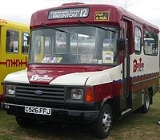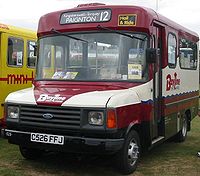
Hail and ride
Encyclopedia

Public transport
Public transport is a shared passenger transportation service which is available for use by the general public, as distinct from modes such as taxicab, car pooling or hired buses which are not shared by strangers without private arrangement.Public transport modes include buses, trolleybuses, trams...
in the United Kingdom
United Kingdom
The United Kingdom of Great Britain and Northern IrelandIn the United Kingdom and Dependencies, other languages have been officially recognised as legitimate autochthonous languages under the European Charter for Regional or Minority Languages...
. Generally, it refers to boarding or alighting a mode of public transport by signalling the driver or conductor
Conductor (transportation)
A conductor is a member of a railway train's crew that is responsible for operational and safety duties that do not involve the actual operation of the train. The title of conductor is most associated with railway operations in North America, but the role of conductor is common to railways...
that one wishes to board/alight, rather than the more
conventional system of using a designated stop. The concept is used primarily in bus
Bus
A bus is a road vehicle designed to carry passengers. Buses can have a capacity as high as 300 passengers. The most common type of bus is the single-decker bus, with larger loads carried by double-decker buses and articulated buses, and smaller loads carried by midibuses and minibuses; coaches are...
transport. The act of requesting a hackney cab to stop is also termed 'hailing'.
Under the specific usage of the term in bus transport, hail and ride refers to the presence of sections of a route which may or may not have regular bus stop
Bus stop
A bus stop is a designated place where buses stop for passengers to board or leave a bus. These are normally positioned on the highway and are distinct from off-highway facilities such as bus stations. The construction of bus stops tends to reflect the level of usage...
s, but it can be requested to board or alight the bus anywhere that it is safe to do so. This is different from the transit bus
Transit bus
A transit bus , also known as a commuter bus, city bus, or public bus, is a bus used for short-distance public transport purposes...
practice employed in some areas, whereby although a stop may exist, it may be a request stop
Request stop
In public transport, a request stop or flag stop describes a stopping point at which trains or buses stop only on an as-need or request basis; that is, only if there are passengers to be picked up or dropped off. In this way, infrequently used stopping points can be served efficiently.Trains save...
where the bus is not required to stop unless the passenger indicates they wish to catch the bus, for instance by holding out their arm at the stop, or indicates they wish to alight, for example by pressing a button to ring the 'stop' bell.
Hail and Ride is usually employed in rural areas, or in non-main roads such as housing estate
Housing estate
A housing estate is a group of buildings built together as a single development. The exact form may vary from country to country. Accordingly, a housing estate is usually built by a single contractor, with only a few styles of house or building design, so they tend to be uniform in appearance...
s. This usually involves routes using minibus
Minibus
A minibus or minicoach is a passenger carrying motor vehicle that is designed to carry more people than a multi-purpose vehicle or minivan, but fewer people than a full-size bus. In the United Kingdom, the word "minibus" is used to describe any full-sized passenger carrying van. Minibuses have a...
es (this is, microbuses or midibus
Midibus
A midibus is a classification of single-decker minibuses which generally are larger than a traditional minibus but smaller than a full-size single decker and can be anywhere between and long...
es) which can navigate these roads easily, although some commuter coach
Coach (vehicle)
A coach is a large motor vehicle, a type of bus, used for conveying passengers on excursions and on longer distance express coach scheduled transport between cities - or even between countries...
routes may also operate on a hail and ride basis at the residential end of their route.
As well as allowing the use of smaller roads less accessible to larger buses, a hail and ride scheme gives the advantage of not having to build bus stop infrastructure in order to introduce or vary a route. To take advantage of some housing estate
Housing estate
A housing estate is a group of buildings built together as a single development. The exact form may vary from country to country. Accordingly, a housing estate is usually built by a single contractor, with only a few styles of house or building design, so they tend to be uniform in appearance...
road layouts, hail and ride may be used at the estate end of a route where the bus traverses the estate in a circular route and returning the other way, rather than ending at a specific terminus
Bus terminus
A bus terminus is a designated place where a bus or coach starts or ends its scheduled route. The terminus is the designated place that a timetable is timed from. Termini can be located at bus stations, interchanges, bus garages or simple bus stops. Termini can both start and stop at the same...
stop.
Sometimes a hail and ride section will be augmented with 'official stops', which are merely posts with a route flag and timetable
Public transport timetable
A public transport timetable is a representation of public transport information to assist a passenger with planning a trip using public transport. A timetable details when vehicle will arrive and depart specified locations and may be organised for by route or for a particular stop...
box, to inform passengers of the existence of the service, rather than a purpose built shelter or lay-by.
The Hail and Ride concept has been extended and forms a part of demand responsive transport
Demand responsive transport
Demand Responsive Transport or Demand-Responsive Transit or Demand Responsive Service or Dial-a-ride or Flexible Transport Services is "an advanced, user-oriented form of public transport characterised by flexible routing and scheduling of small/medium vehicles operating in shared-ride mode...
schemes.
The Hail and Ride may be appropriate to retain ‘Hail & Ride’operation:
- on lightly used services;
- on routes where passenger demand is very scattered; or
- where local conditions make installation of bus stops difficult (i.e. narrow pavementSidewalkA sidewalk, or pavement, footpath, footway, and sometimes platform, is a path along the side of a road. A sidewalk may accommodate moderate changes in grade and is normally separated from the vehicular section by a curb...
s).
The hail and ride concept is adopted in Hong Kong by all minibus
Public light bus
A Public light bus is a common public mode of transport in Hong Kong. It mainly serves the area that standard Hong Kong bus lines cannot reach as efficiently. It is also colloquially known as a minibus or a van, defined as a kind of share taxi....
routes, although many minibus routes also have some sign posts along their routes, and a minority of operators do encourage their customers to get on and off at these stops.

